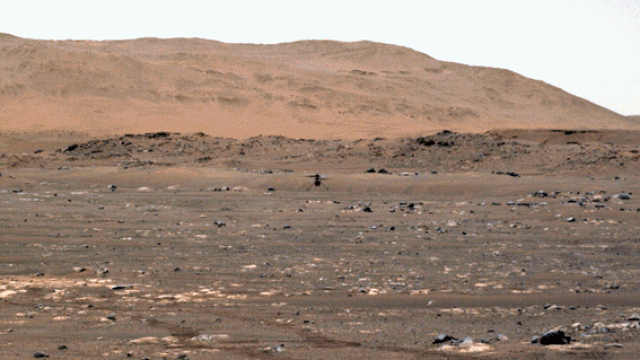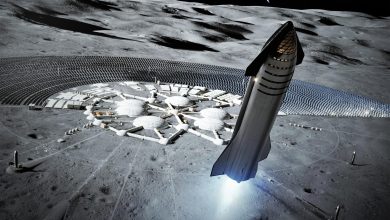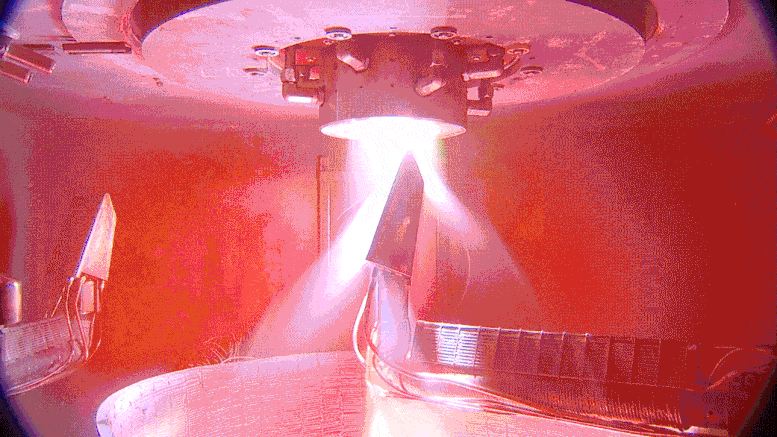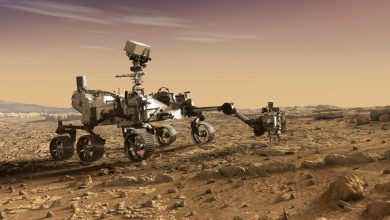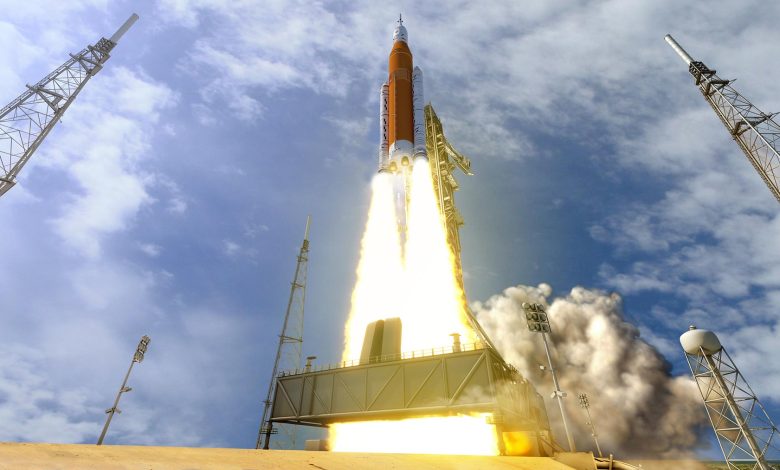
NASA’s Space Launch System rocket will launch with Orion atop it from Launch Complex 39B at NASA’s modernized spaceport at Kennedy Space Center in Florida. Credit: NASA
Have you ever wondered what it takes to assemble the most powerful rocket NASA has ever built? Watch documentary footage of NASA’s Space Launch System (SLS) rocket’s transformation into the over-300-foot-tall launch vehicle that will return humanity to the Moon.
Starting with manufacturing and ending with stacking operations inside NASA Kennedy Space Center’s Vehicle Assembly Building, this is only the beginning of SLS’s path to the launch pad.
Video Transcript:
NASA is preparing for a journey back to the Moon, and after that, we’re setting our sights on Mars.
To get there, we need tons of rocket power, coming from our Space Launch System.
When it comes to how much power this thing can push out, this thing is massive. It’s going to be mesmerizing to stand next to this massive vehicle.
The immensity of it, knowing that this thing is going to be propelling a rocket into space and around the moon.
Hang on, it’s probably best to start back at the beginning.
It all started in Promontory, Utah, where Northrop Grumman manufactured each of the segments that make up the rocket’s boosters.
After a 10-day, cross-country journey, the booster segments were delivered to Kennedy Space Center’s Rotation, Processing, and Surge Facility, or RPSF. If this all sounds familiar, that’s because it’s the same facility that was used to process shuttle booster segments, which all came from Utah.
Then, they’re ready to go into the iconic Vehicle Assembly Building, or VAB, where the rest of the motor segments are assembled and stacked on top of the mobile launcher.
The one thing about this vehicle, of course, it’s produced all across the country. The components all come here. They may be built around the country, but they all come together right here in the Vehicle Assembly Building.
Our SLS rocket will generate 8.8 million pounds of thrust to break through Earth’s gravitational pull. That’s more power than the Space Shuttle and the Saturn V rocket used.
Teams with NASA’s Exploration Ground Systems are responsible for assembling the boosters that will house the majority of that power. The twin solid rocket boosters, made up of 10 total motor segments, will stand nearly 17 stories tall when fully stacked.
First, teams inspect and prep the hardware. Next, they’re ready to start stacking the segments – a process that takes time, patience, and a steady hand.
Once we have everything done in High Bay 4, we pick up the segment with a 325 foot crane, pick it up over the 16th-floor crossover to where you see it now, and we begin stacking the segments. Each segment we lift over the 16th-floor crossover and stack it. Once we stack it, we put it on top of the segment below, and we put about 177 pins all the way around the whole thing to attach each segment.
And, the pressure to perform the operation flawlessly can test the team’s nerves.
There’s a tremendous responsibility involved with processing flight hardware like this. It’s nerve-racking at times, but it’s exciting. There’s zero appetite for risk in a program like this.
We have a bunch of shuttle guys that are here to show us along the way. If we get stuck, they’re there to guide us. At the beginning of stacking, it was very of nerve-racking. With each segment that we stacked, a little bit of the nerve comes off. By the third or fourth one, it’s easy-peasy. We’re pushing through, all the jitters are gone, and we’re just excited to get finished with it.
With all 10 booster segments now fully stacked on the mobile launcher, there’s just one final piece of the puzzle to round out the power needed to get SLS off the ground and send it to space: core stage.
After a 900-mile voyage aboard NASA’s Pegasus barge, the SLS core stage – the
largest rocket stage NASA has ever built – has made it to Kennedy Space Center.
Today is a huge day. This is the last piece of big hardware that we need for Artemis 1 hard processing. And we’ve just been waiting a long time for this part of the vehicle to arrive so that we can get going on the next steps of our stacking operations.
Standing an impressive 212 feet tall, and weighing a whopping 188,000 pounds, the core stage came all the way from Stennis Space Center in Mississippi. The core stage went through round after round of rigorous testing, including what’s called its Green Run series, truly putting its performance to the test.
The series involved eight rounds that looked at systems individually before culminating in pure power. With over 700,000 gallons of propellant flowing through the core stage, and its RS-25 engines firing for eight minutes straight, the successful final test resulted in some big emotions from the team.
We cried, we laughed, and we cheered because it was so emotional to see
the years of culmination coming through.
And, that victory did not come without overcoming a few challenges, proving why at NASA we test as frequently and as hard as we do.
We actually did a one-minute test on the first hot-fire test and then we learned a lot from that. We understood the vehicle more, we made a few changes, and then we got back into our second hot-fire test.
There was a lot of joy and workmanship and ownership of being able to work that process and be able to get it done. When we went for the second hot fire, and we went for the 500 seconds, that was just pure exhilaration.
Following its arrival at Kennedy, teams moved the core stage into the VAB, where it was lifted by crane and placed in between the twin solid rocket boosters.
Serving as the backbone of the rocket, the core stage will provide more than 2 million pounds of thrust to help send the Orion spacecraft on its trip around the Moon.
Essentially, we have these two massive cranes that are located inside of the VAB, where we go ahead and we pick two points at the end of the core stage – one on the back portion of it and on the front portion of it – we lift it up to the point where we’re able to transition it from a horizontal position over into a vertical position, and then essentially bring it way up to the top of the Vehicle Assembly Building and cross it over into High Bay 3, in which we ensure that we don’t damage any part of the vehicle as it’s incoming into its position.
NASA’s largest rocket stage, now fully integrated with the twin boosters, is ready to get Orion off the Earth. But, it will take one more critical component to give the capsule that extra push it needs to journey tens of thousands of miles beyond the Moon.
With just a single RL10 engine, the interim cryogenic propulsion stage, or ICPS, will provide over 20,000 pounds of thrust to send Orion on the ride of a lifetime.
To connect the ICPS with the rocket stack, teams next added the launch vehicle stage adapter to the core stage, followed by the ICPS.
The ICPS is the interim cryogenic propulsion stage and essentially, it’s somewhat of the upper stage of the entire SLS vehicle. And what that will do is propel the Orion capsule along with the service module over to its destination, which at this point in time will be the Moon.
But, before the spacecraft can be attached to the rocket, teams will conduct a series of tests to ensure all of SLS’s components communicate properly with one another, plus the ground systems equipment, the Launch Control System, and its software.
Adding to the challenge, those methods for testing have changed significantly since the days of the Apollo Program.
Initially built in the 1960s to house the assembly of the Saturn V, the largest rocket made by humans at the time for Apollo missions to the Moon, the VAB has undergone some major modifications to support several different kinds of rockets and spacecraft, whether they’re going into low-Earth orbit or venturing to deep space.
This high bay was Shuttle heritage. Before that it was Apollo heritage. There’s upgrades that are still occurring today to include upgrades that will support Artemis II and Artemis III.
When SLS blasts off from Kennedy’s Launch Pad 39B, Orion isn’t the only thing it will be sending to space. Hitching a ride with Orion are tiny, shoe-box sized satellites – called CubeSats – that were loaded into the Orion stage adapter in Kennedy’s Space Station Processing Facility.
The extra room in the stage adapter provides a rare opportunity to send those CubeSats to deep space to conduct science and research of their own.
And, these CubeSats are on tap to study a range of topics – from the Moon, to asteroids, to the effect of space radiation on living organisms.
At this point, the stack is nearly complete – all that’s missing is the spacecraft itself, which has been in the Launch Abort System Facility getting outfitted with one of the spacecraft’s most crucial pieces.
The launch abort system is kind of that pointy solid rocket motor that’s at the top of Orion, and it’s there to protect the crew in the event of an emergency so it’s a very important system. Fully integrated with its launch abort system, the Orion spacecraft slowly makes its way to the VAB in the overnight hours.
Upon its arrival, teams carefully lift and lower it onto the Orion stage adapter. With this operation, stacking the most powerful rocket the world has ever seen is complete – and, what a sight to behold.
We’re trying to decide what does exploration look like in the future when we retire Shuttle? You know, what does our nation want to do? Where do we want to go? How do we want to explore?
To see it go from those days of words and ideas in people’s heads to the three programs we have today and the Artemis mission and all the hardware that’s been produced in factories ranging from, big aerospace companies to little mom and pop shops all over the country and the world, it’s unbelievable. I’m just really proud.
Before SLS and Orion can launch our nation into a new era of space exploration, a series of tests need to take place inside the VAB, validating the rocket and spacecraft as an integrated system and paving the way for one, final milestone: wet dress rehearsal.
The 322-foot-tall, fully integrated rocket will roll out to Launch Pad 39B for a full test, allowing the launch team to run through a full launch countdown but stopping just short of firing the engines.
I think we’re going to be so proud when it rolls out of the VAB. I will personally be probably crying a little bit because it’s such a big event. We worked so hard to get us to the day of rolling out. I’m probably going to be bawling when we launch it, see it through my tears, because it’s just a culmination of so much work from everybody.
We owe the advancement of science and research and technology to what we’re doing here. And, this is a big opportunity for us as a nation to reclaim our spot at the forefront of human space flight and exploration.
Artemis is going to be a major part of history. It most definitely is going to rock the space industry when it flies.
This program is going to go to the Moon. It’s going to go to Mars. We need that. This country needs that. This world needs that.
I’m so excited. It’s going to be a lot of work, a lot of work ahead of us, but Artemis I is going to surprise everybody.

